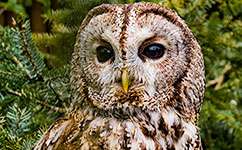Owls in trouble in a changing world

Tawny owls are threatened with long-term decline because environmental change is dampening the population cycles of their favoured prey, a new study has shown. If the situation continues, the owls will slowly die out over the coming decades.
Scientists analysed 27 years of data on owl populations and breeding patterns in Kielder Forest in Northumberland alongside the results of an earlier study. The latter showed field vole populations across Europe, which until recently fluctuated wildly from year to year, are becoming much more stable.
Voles are the cornerstone of the tawny owl diet, accounting for some 62 per cent of their prey. They're so important that the owls often can't breed at all unless the rodent populations grow dense enough. So owls are better off in a situation with some terrible years and some plentiful ones than in one with a constant mediocre vole supply, since the latter probably means few will ever manage to breed successfully.
Scientists already knew that like others across Europe, the Kielder vole population now varies less from year to year than it did until the 1990s. They suspected this would affect the voles' predators, but this study is the first conclusive evidence to support this. It shows that the impact of environmental change is cascading through ecosystems, affecting first herbivores, then the predators that eat them.
The decline is slow, and would be hard to detect simply by monitoring the number of adult owls. This is partly because an increasing number of owls from outside Kielder have arrived since the study began, helping mask the general drop in fecundity. It's also because the owls are so long-lived – 8-10 years on average, and in some cases up to 20 – so it takes time for the population to respond to a change in its ecosystem. But the researchers' population model suggests the ultimate results will be disastrous.
'The owl population is ageing, and unless regular vole outbreaks return they eventually will die out – although that could be decades away,' says Professor Xavier Lambin of the University of Aberdeen, senior author of the paper, published in Global Change Biology. 'It's just getting much harder for them to breed. For a sustainable population you need some years of plenty to create big age cohorts that then move through the population, but these years aren't happening any more.'
He adds that the work is a testament to the great value of collecting large amounts of data about the natural environment over long periods – this is the only way to pick up subtle trends in their early stages. The Kielder tawny owl monitoring programme is unusual in that it covers predators, whereas most comparable projects focus on herbivores.
'We could only do this work because we had access to this unique dataset,' says Lambin. 'Tawny owls are very long-lived animals so if you just look at the number of individuals the situation might look reassuringly stable, but if you have more deaths than births there is only one possible outcome in the long term.' 'We also quantified to what extent such predictions could be altered by changing climate' adds Dr Alexandre Millon, the lead author of the paper and now a lecturer at Aix-Marseilles University in France. 'We found that owl reproduction deteriorates further after wet and miserable winters, but the effect of vole scarcity on owls was much stronger than climate'.
The wider raptor monitoring programme is run by the Forestry Commission. Neville Geddes, planning and environment manager for the North England forest district, says his organisation first started the study three decades ago in an effort to understand the effects of changes in its management of Kielder. Large-scale felling was about to start, and ecologists weren't sure how this would affect the tawny owls. In the event, it helped them significantly, giving them more vole-rich open areas in which to hunt. Under the scheme, all owls are ringed and the number of eggs laid, chicks hatched and finally chicks fledged in each nestbox is monitored.
'By monitoring the owls we can get an idea of how changes in how we manage the forest are affecting its ecology,' he says. 'We're very proud of the programme. I believe there isn't a comparable study that covers such a long period and such a big area – Kielder is the biggest planted forest in northern Europe.'
This is one of the first studies to establish that the effects of environmental change on the population cycles of 'keystone herbivores' also have a serious effect on their predators. There have been previous studies of the impact of the dampening of lemming population cycles on the arctic foxes and sea skuas that eat them, but these could not draw on such a rich historical dataset.
We know from Lambin's earlier research that vole population cycles are declining all over Europe, and that environmental change is probably responsible. Many other keystone herbivores face similar fates; for example, there is evidence that populations of some plant-eating insects are fluctuating less than they were. Lambin says there will be huge implications for many other predators – for example, voles are essential not just for owls, but also for other animals including foxes, badgers, raptors, weasels and stoats. The most vulnerable predators are those whose breeding success is highly dependent on vole populations in winter and spring.
More information: Alexandre Millon, Steve J. Petty, Brian Little, Olivier Gimenez, Thomas Cornulier, Xavier Lambin. "Dampening prey cycle overrides the impact of climate change on predator population dynamics: a long-term demographic study on tawny owls." Global Change Biology, DOI: 10.1111/gcb.12546.
Journal information: Global Change Biology
Provided by PlanetEarth Online
This story is republished courtesy of Planet Earth online, a free, companion website to the award-winning magazine Planet Earth published and funded by the Natural Environment Research Council (NERC).
















